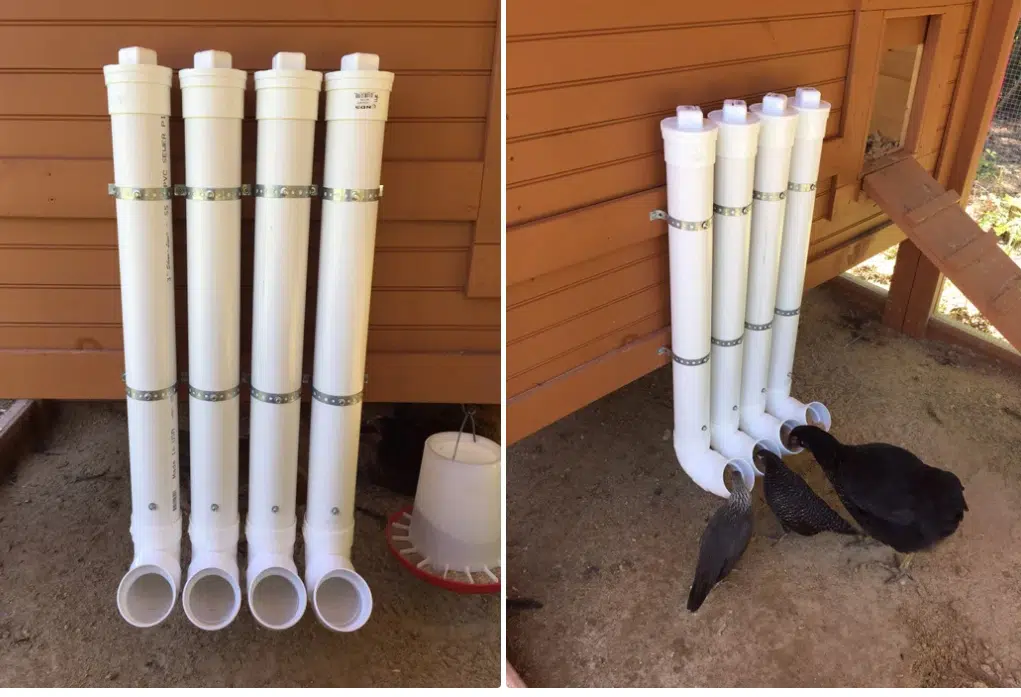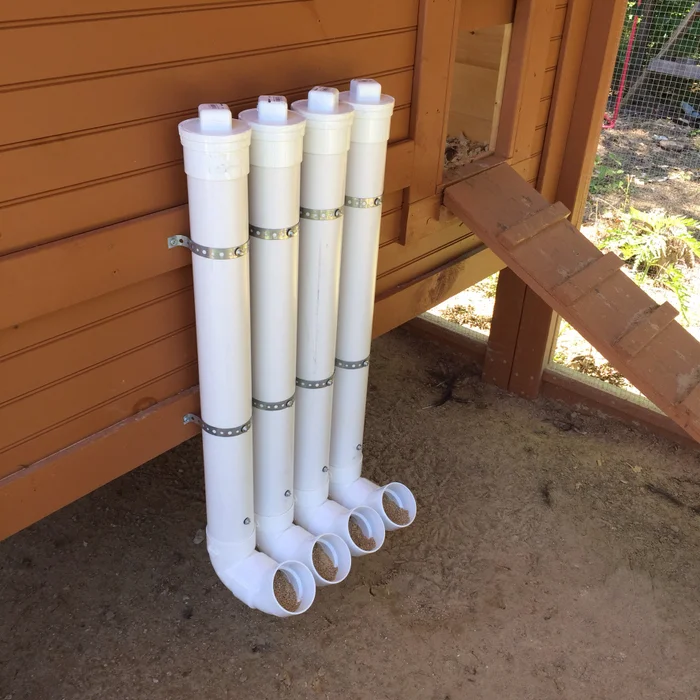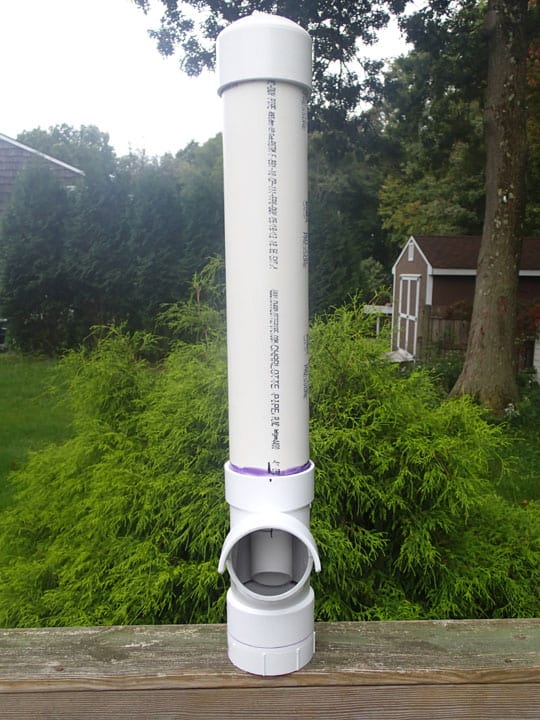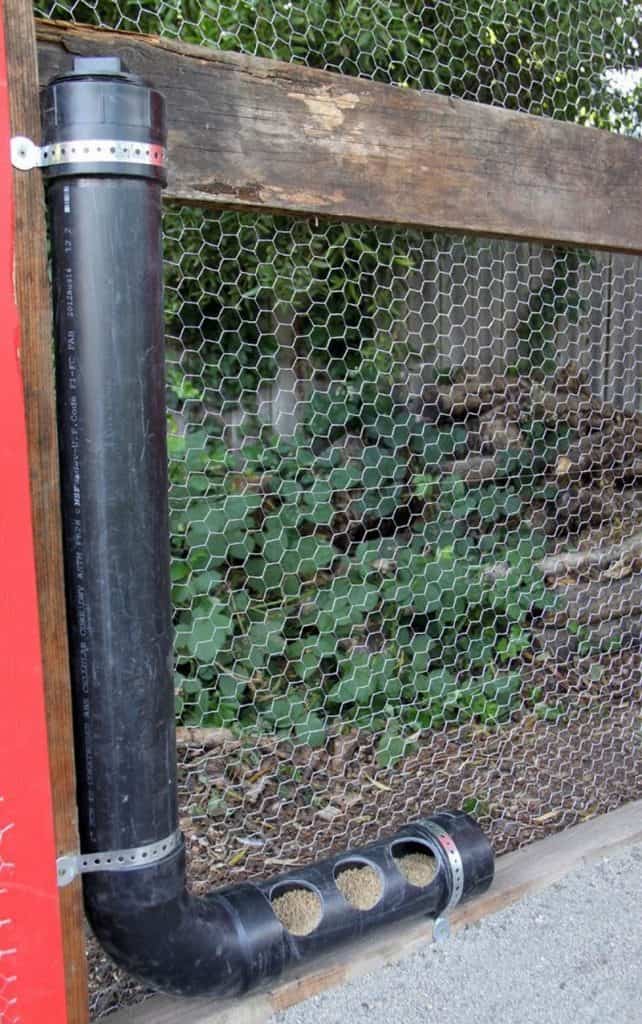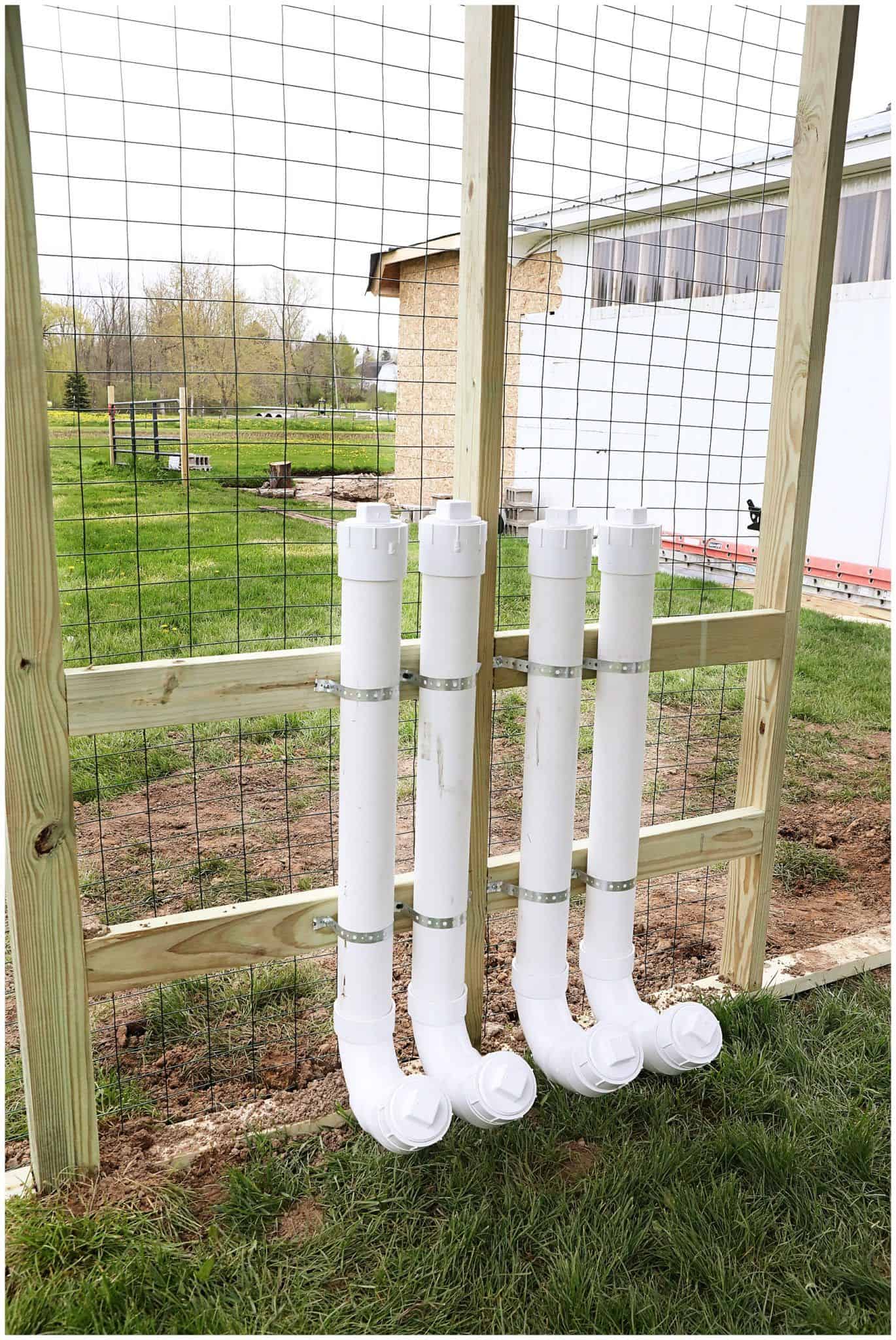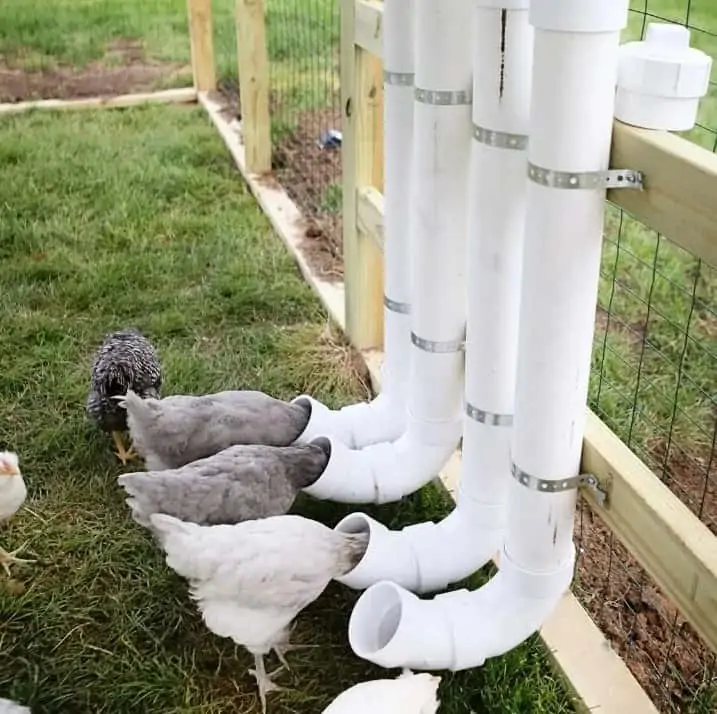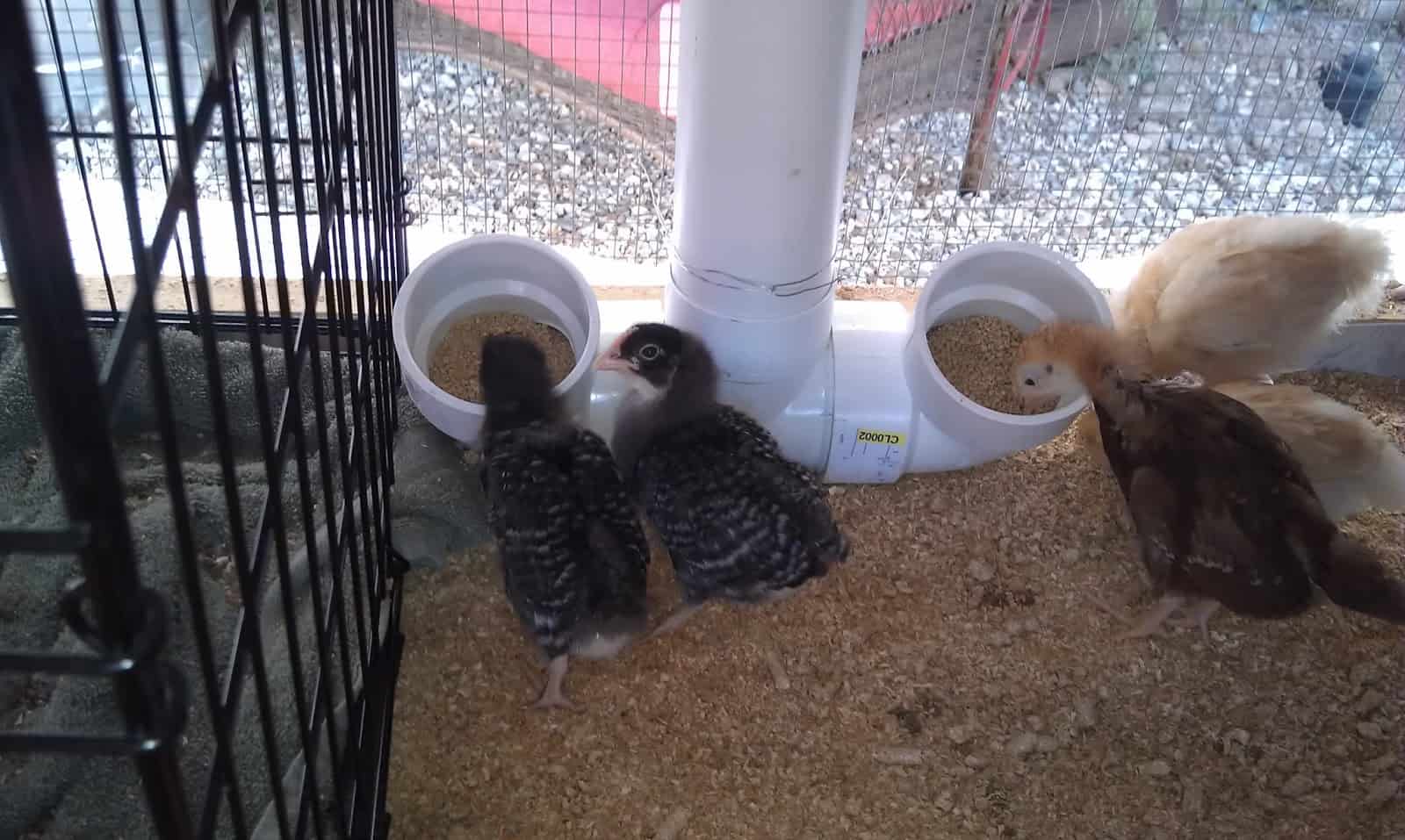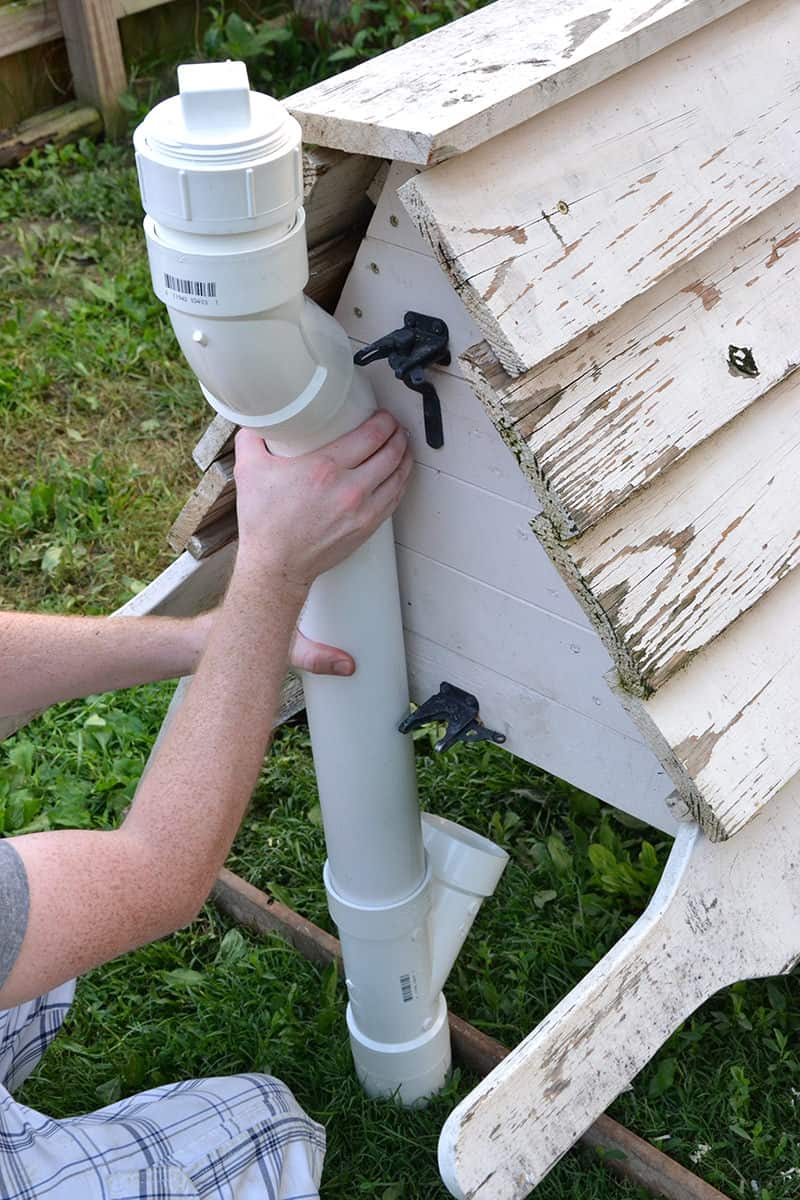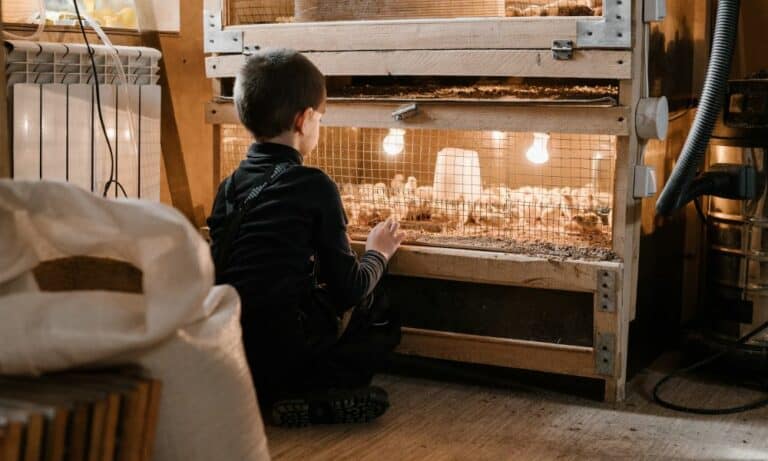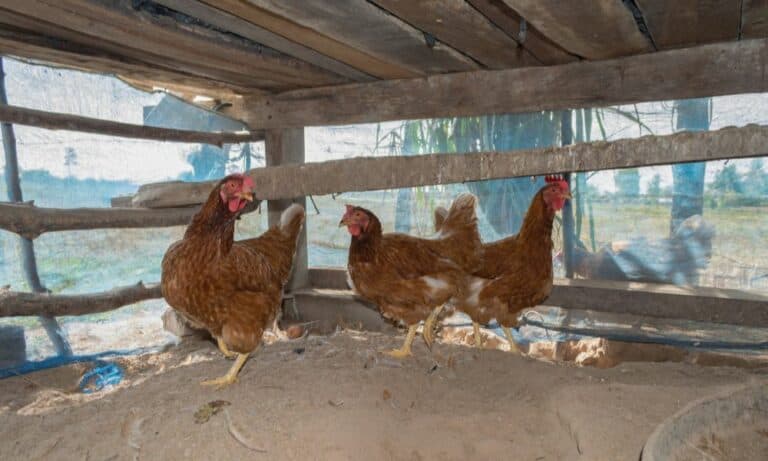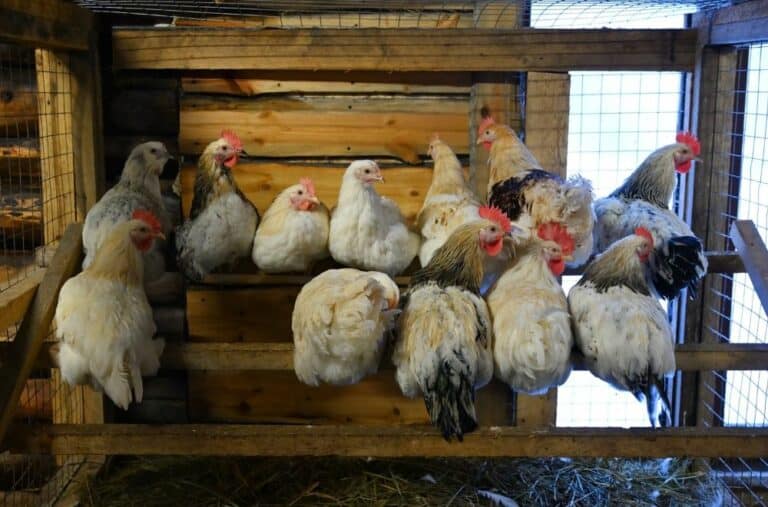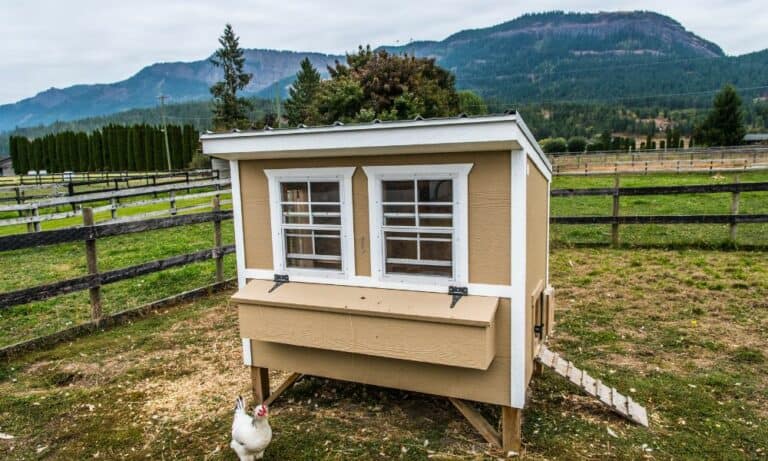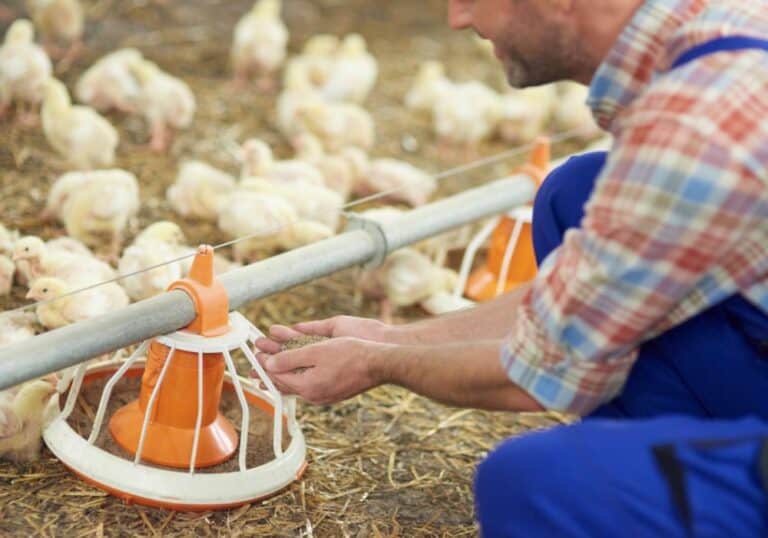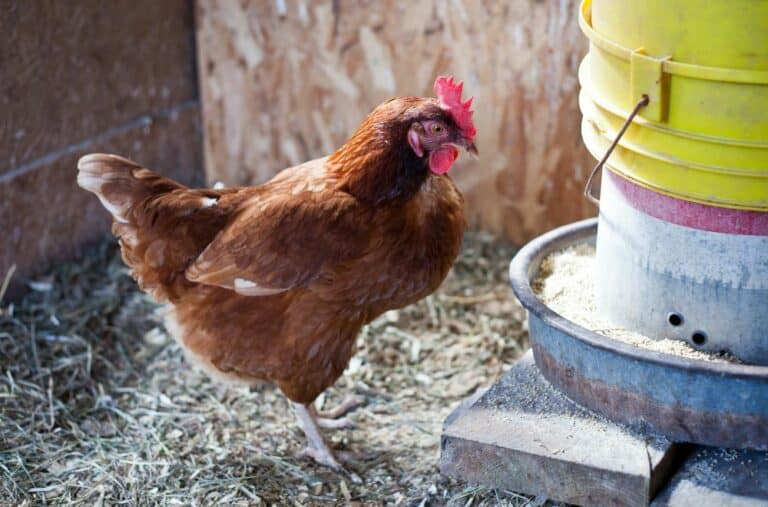Some people raise poultry commercially, selling their meat and chicken on a large scale. Others keep a handful of hens for eggs or as free-range pets. Either way, a DIY PVC chicken feeder can cut costs and raise profits. PVC is the type of hard plastic used in pipes and food-grade buckets.
PVC (polyvinyl chloride) is different from other types of plastic like the PET used in soda bottles (polyethylene terephthalate), the polypropylene from water tanks, or the ABS used in electronics (acrylonitrile butadiene styrene). Let’s learn how to make affordable chicken feeders using PVC.
1. DIY Chicken Feeder Out of PVC – Chicken Chaser Bri
We’ll start with something super simple. It only has one feeding spout so it works best for backyard pets. Only one or two chickens can use it at a time, so if you have more than five birds, you need to make multiple feeders, and that’s a lot of extra work! You need a PVC pipe with a Y-trap.
This pipe has an outlet that points upward in a Y-shape, and that’s where the chicken feed comes out. Fit an end cap at the bottom of the pipe and add a hollow extension at the top where you’ll gravity-load the feeder. You can add a removable cap or rain guard on top to keep the food dry.
2. PVC Chicken Feeder – Jason Roberts
DIY PVC chicken feeders can be oriented vertically or horizontally. Vertical feeders aka gravity feeders use nature’s downward force to control volumes, so they’re less messy. But horizontal feeders offer a wider feeding surface for the same length of pipe so they can serve more birds.
This tutorial has simple vertical feeders. You can line them up in fours or sixes if you have more birds. Use end caps with square knobs for easy handling, and secure them with metal brackets. For the outlets, use two adapters – an elbow and an L. Angle them upward to reduce spillage.
3. Easy PVC Pipe Chicken Feeder – Outsider Abb
Here’s an idea you can try for 4 to 8 chickens. Especially if you have a few basic power tools and you know how to use them. You’ll need a hole saw and a hacksaw. It helps to run the hole saw in reverse since it’ll cut through the plastic easier. Don’t forget to sand and smoothen your holes!
You need two PVC pipes – roughly 18 inches and 36 inches. The shorter pipe can hold up to four feeder holes, so adjust the length as needed. Get an elbow adapter to connect the two pipes, and two end caps to protect the chicken feed from moisture. Test your hole saw on scrap PVC first.
4. PVC Chicken Feeder – Instructables
After you’ve made a few of these DIY PVC chicken feeders, you’ll notice their framework is basically the same. But as this tutorial shows, a few simple tweaks can elevate the style of your chicken feeder, both visually and functionally. This enhances your aesthetics and bird hygiene.
For these feeders, set up a wooden support to attach them to the wall and keep them steady, even when hungry chickens jostle them. Use screws and bolts to join the tubes – it’s cleaner and less messy than glue. Add half an end cap to the feeder spout to prevent wastage as the birds eat.
5. How to Make 3 Different Chicken Feeders with PVC
If you can’t decide on the orientation of your chicken feeders (or if you have finicky birds), try these three styles and see what you – and your chicken – like best. It’ll only take you an hour to complete all three, and you can swap them periodically to keep your birds mentally stimulated.
One option is to cut holes in the pipe, just like we saw earlier. Place the holes slightly to the side to prevent your birds from crowding and hurting each other. Option #2 is to slice a rectangular hole on the top for a wider feeding surface. Or #3, set it up vertically with a tub or trough below.
6. DIY Dine-A-Chook PVC Feeder
Not everyone wants to get their hands dirty, so you can buy the Dine-A-Chook tube feeder for about $50. But it’s an Australian brand, so the wait time and shipping costs may be a problem. You can reverse-engineer your own version though. And it’ll be pretty high-end if you do it right.
Aside from the usual 3” PVC pipe, end caps, and Y-trap, you’ll need a narrower 1.5” PVC pipe. It goes inside the wider tube to slow the flow of chicken feed. By lowering the pace of your gravity feeder, the feeding process makes less of a mess. Slit a protective hood using the upper Y-trap.
7. Seven-Piece PVC Chicken Feeder – Dead Eye Duane
Using an adapter with a Y-trap takes a lot of extra steps out of the chicken feeder construction process. But if you don’t have that upward-arrow shape handy, you can still use a standard T adaptor and slice off the end diagonally. It’ll still form a roofing ledge and get the job done.
Inside the outer tube, use a reducer to connect a narrower pipe. This manages the speed and level of food delivery so there’s no contamination or overflow. The final modification is to set a drainpipe end cap with grids in it. This prevents run-off from entering the feeder when it rains.
8. How to Build an Inexpensive Chicken Feeder from PVC – OBN
DIY PVC chicken feeders have two basic structures – a J-shape with a short feeder outlet or an L-shape with a long feeder outlet. So the main difference between your feeders is how you set up the feeding spout. For the gravity section, use a long tube, an end cap, and a 90° elbow adapter.
With the feeder outlet, you have options. Try a dual Y-trap or a T-adaptor with a spout on either side to make a double feeder. You can carve an ellipse into the top of the L-tube to enlarge your feeding surface. Or cut a hood to keep the rain off. Or use an extender to push the outlet farther.
9. Candy Cane Chicken Feeder – Nature’s Always Right
As we said earlier, a few design tweaks can elevate your basic DIY PVC chicken feeder into something elite and premium. In this demo, the vertical parts of the feeder are tucked out of sight behind the hen house. And by using two elbow adaptors, you form a deeper outlet curve.
On the hen-end, use rectangular downspout pieces to make a boxy feeding trough that’s pretty, practical, and eye-catching. The only downside of these candy cane feeders is you have to fill them from behind, so they won’t work if your chicken coop doesn’t have a rear access point.
10. Pest-Free DIY Chicken Feeders from PVC – Sugar Maple Farm
For most PVC chicken feeders, the tubes, elbows, and end caps are twisted into place without additional fasteners. This works great because the tubes are carefully sized straight from the factory. This facilitates their modular use in plumbing and construction. They’re measured to fit.
But moisture and pests can still slip through the gaps. So you could add caulk to seal the joints between the pipes. Avoid drilling since this offers additional entry points. Also, use threaded end caps with knobs so you can screw them shut. A screw cap at the bottom is ideal during the night.
11. DIY Automated Chicken Feeder – Danielle’s Joy Urban Homestead
You don’t have to restrict your DIY PVC chicken feeder to tubes and pipes. You can make a far simpler option if you just grab some food-grade 5-gallon buckets. But make sure they’re strong PVC rather than the softer PET or polyethylene used in soft drink bottles and 5-gallon tanks.
Reason being those water containers aren’t sturdy enough to handle a horde of hungry hens. Their beaks and claws could poke right through! For the feeding trough, cut the bottom of a wider bin and ensure it’s about 3” high so it can hold a decent amount of food. Higher lips reduce wastage.
12. Deep Dish DIY PVC Chicken Feeder
The best way to reduce waste when you’re building a chicken feeder is to design a deeper spout. If your chickens have to stick their entire head and neck inside the feeder outlet, they have less room to spill. But ensure the tube is hollow enough that the bird won’t suffocate while it feeds.
And remember that if you’re using this style of feeder, you’ll need a lot more of them since only one chicken can feed at a time. But the upside is you can calculate the height of your gravity feeders with the number of birds you have. That way, you only refill them once a week or month.
13. Cheap Chicken Feeder – Rob Bob’s Aquaponics
Following on the idea of a deep-dish chicken feeder, here’s a boxy Australian alternative. With local PVC feeders, we tend to put the elbow adaptor on the outside. But this concept sticks it on the inside to cut down the amount of wasted chicken feed that ends up on the floor of the coop.
Rather than a round bucket or PVC tube, use a square or rectangular PVC tub and an elbow flange that has a protective outer lip. Be sure to give the adaptor enough clearance so that the chicken feed can slip under it. Raise the feeder with a sturdy step or brick so the hens can reach it.
14. T-Shaped DIY Chicken Feeder – Backyard Chicken Lady
We’ve mentioned the T-shaped DIY PVC chicken feeder a few times in this article. Now let’s take a closer look at how you can construct one. It’s a basic gravity feeder except it has two feeding outlets for every pipe so more of your hens can eat at the same time. And it works for chicks too.
Building it is simple. Instead of putting an elbow adaptor at the end of the vertical tube, fit a T-adaptor. You can then use tube extenders to push them out farther if you prefer. For longer sections, cut rectangular trough-like holes. For shorter feeders, attach an elbow at each end.
15. Chicken Feeder (Easy & Cheap DIY PVC Pipe) – I am Will
Horizontal PVC feeders make more sense if you have multiple chickens. Otherwise, some of your milder hens may get so bullied that they’ll never eat, and you may not notice until the poor girls are shriveled down to nothing! But if you don’t want the fuss of an L-shaped feeder, hang one!
This design has the same basic idea. It’s a pipe with holes strategically drilled into the top. But the end caps have sturdy ropes or straps holding them up at a suitable height for your chickens. You may need to place a collection tray at the bottom to catch any chicken feed that spills out.
16. Head-In Y-Trap PVC Chicken Feeder – Hobby Farms
Y-traps are the perfect solution when you’re building the type of PVC chicken feeder that ensures full insertion. And you can adjust the height and depth of the spout to ensure your chickens have easy access with minimal spillage. Plus, adaptors come with pre-smoothed edges!
This feeding rig is built on the outside of the coop with only the feeding spout on the inside, so you need rear access to refill it. The coop in this demo is a wooden teepee or tractor so it’s quite stable. If you’re using this type of feeder on a wire hen house, you’ll need to reinforce the walls.
17. DIY Automatic Chicken Feeder | Simple PVC Design | 5-Minute Build For $12
Our final DIY chicken feeder is also our quickest! So if you felt overwhelmed by those lengthy, complex builds, try these five-minute tips. You don’t need any power tools – a simple hacksaw will do. But fair warning, it involves a lot more sweat and elbow grease to slice PVC by hand.
This feeder has four parts – two end caps, a T-adaptor, and a PVC tube. If pricing is a problem, ask the hardware store for sewer pipes instead of standard PVC. It’s significantly cheaper but just as effective. And while it’s easier to cut through, it’s equally waterproof, safe, and hygienic.
Do you have other techniques for making DIY PVC check feeders? Show us in the comments!

